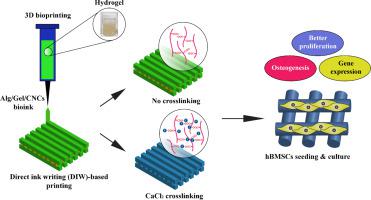International Journal of Biological Macromolecules ( IF 7.7 ) Pub Date : 2020-12-05 , DOI: 10.1016/j.ijbiomac.2020.12.011 Sayan Deb Dutta , Jin Hexiu , Dinesh K. Patel , Keya Ganguly , Ki-Taek Lim

|
The 3D-printed hybrid biodegradable hydrogels composed of alginate, gelatin, and cellulose nanocrystals (CNCs) were prepared to provide a favorable environment for cell proliferation, adhesion, nutrients exchange, and matrix mineralization for bone tissue engineering (BTE) applications. The hybrid scaffolds exhibited enhanced mechanical strength compared to the pure polymer scaffolds. The biocompatibility, differentiation potential, and bone regeneration potential of the printed scaffolds were evaluated by DAPI staining, live-dead assay, alizarin Red-S (ARS) staining, real-time PCR (qRT-PCR), and μCT analysis, respectively. Enhanced cell proliferation has occurred 1% CNC/Alg/Gel scaffolds compared to the control. The cells were adequately adhered to the scaffold and exhibited the flattened structure. Improved mineralization was observed in the 1% CNC/Alg/Gel scaffolds' presence than the control, showing their mineralization efficiency. A significant enhancement in the expression of osteogenic-specific gene markers (Runx2, ALP, BMP-2, OCN, OPN, BSP, and COL1) has occurred with 1% CNC/Alg/Gel than the control, indicating their osteogenic potential. Furthermore, enhanced bone formation was observed in the scaffolds treated groups than the control in the calvaria critical-sized defects (CCD-1) model, suggesting their improved bone regeneration potential. Therefore, the fabricated scaffolds have the potential to explore as a biomaterial for tissue engineering.
中文翻译:

海藻酸盐/明胶/纤维素纳米晶体的3D打印生物活性和可生物降解的水凝胶支架,用于组织工程
制备了由藻酸盐,明胶和纤维素纳米晶体(CNC)组成的3D打印杂化可生物降解水凝胶,可为骨组织工程(BTE)应用的细胞增殖,粘附,营养交换和基质矿化提供良好的环境。与纯聚合物支架相比,杂化支架表现出增强的机械强度。通过DAPI染色,活死分析,茜素Red-S(ARS)染色,实时PCR(qRT-PCR)和μ评估印刷支架的生物相容性,分化潜能和骨再生潜能CT分析,分别。与对照组相比,发生了1%的CNC / Alg / Gel支架增强的细胞增殖。细胞充分粘附到支架上并显示出扁平的结构。在存在1%CNC / Alg / Gel支架的情况下,与对照相比,矿化得到了改善,显示了它们的矿化效率。成骨特异性基因标记(Runx 2,ALP,BMP-2,OCN,OPN,BSP和COL1)的表达显着增强)的CNC / Alg / Gel含量比对照组高1%,表明它们具有成骨潜能。此外,在颅骨关键尺寸缺损(CCD-1)模型中,与对照组相比,在支架处理组中观察到增强的骨形成,这表明它们改善了骨再生的潜力。因此,制造的支架有潜力探索作为组织工程的生物材料。











































 京公网安备 11010802027423号
京公网安备 11010802027423号